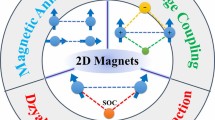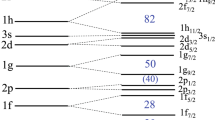Abstract
Dinuclear and tetranuclear complexes of spin-coupled manganese-manganese, manganese-iron, and iron-iron ions occur in enzymes which are of importance in biology and photosynthesis. These multinuclear systems contain higher oxidation states of manganese and iron ions than those of the commonly occurring Mn(II) and Fe(III) mononuclear ions, in which there has been a lot of interest recently with regard to their electron paramagnetic resonance (EPR) spectra. In order to aid the interpretation of EPR spectra, the spin Hamiltonians, and the resulting energy levels, characterizing binuclear and tetranuclear manganese ions will be discussed in this presentation. These will include, in particular, Mn(II)−Mn(III), Mn(III)−Mn(IV), and Mn(IV)−Mn(V) systems for the binuclear situation, and the Mn4O2 “butterfly”, cubane, dimer of dimer systems, and diamond structure for the tetramer situation. These coupled systems are characterized by a variety of exchange interactions whose magnitudes and nature, ferromagnetic or antiferromagnetic, affect profoundly the energy levels. In addition, the hyperfine interactions amongst the various55Mn nuclei produce a complex EPR spectrum consisting of a large number of hyperfine lines. In order to interpret EPR spectra properly, one needs to simulate them as accurately as possible. Details of a rigorous technique for the simulation of EPR spectra of these systems with matrix diagonalization and homotopy technique will be provided.
Similar content being viewed by others
References
Misra S.K. in: Handbook of Electron Spin Resonance (Poole C.P., Farach H.A. eds.), chapt. 7, p. 115. New York: A.I.P. Press, Springer 1999.
Goldberg D.P., Telser J., Krzystek J., Montalban A.G., Brunel L.C., Barrett A.G.H., Hoffman B.M.: J. Am. Chem. Soc.119, 8722 (1997)
Schafer K.O., Bittl R., Zweygart W., Lendzian F., Heselhorst G., Weyhermüller T., Wieghardt K., Lubitz W.: J. Am. Chem. Soc.120, 13104–13120 (1998)
Brudvig G.W. in: Advanced EPR: Applications in Biology and Biochemistry (Hoff A.J., ed.), pp. 839–863. Amsterdam: Elsevier 1989.
Zheng M., Dismukes G.C.: Inorg. Chem.35, 3307–3319 (1996)
Proserpio D.M., Hoffman R., Dismukes G.C.: J. Am. Chem. Soc.114, 4374–4382 (1992)
Belinski M.I.: Chem. Phys.176, 15–36 (1993)
Belinski M.I.: Chem. Phys.179, 1–22 (1994)
Belinski M.I.: Chem. Phys.189, 451–465 (1994)
Kambe K.: J. Phys. Soc. Jpn.5, 48–51 (1950)
Budvig G.W., Crabtree R.H.: Proc. Natl. Acad. Sci. USA83, 4586–4588 (1986)
Kusunoki M. in: Proceedings of the XIIth International Congress on Photosystems, S13–008. Collingwood: CSIRO Publishing 2001.
Zouni A., Witt H., Kern J., Fomme P., Krausb N., Saenger W., Orth P.: Nature409, 739–743 (2001)
Messinger J., Nugent J.H.A., Evans M.C.W.: Biochemistry36, 11055–11060 (1997)
Messinger J., Robbler J.H., Yu W.O., Sauer K., Yachandr V.K., Klein M.P.: J. Am. Chem. Soc.119, 11349–11350 (1997)
Åhrling K.A., Peterson S., Syring S.: Biochemistry36, 13148–13152 (1997)
Åhrling K.A., Peterson S., Syring S.: Biochemistry37, 8115–8120 (1998)
Abragam A., Pryce M.H.L.: Proc. R. Soc.206, 135–153 (1951)
Boussac A., Kuhl H.K., Ghibaudi E., Rögner M., Rutherford W.A.: Biochemistry38, 11942–11948 (1999)
Bencini A., Gatteschi D.: EPR of Exchange Coupled Systems. Berlin: Springer 1990.
Åhrling K.A., Pace R.J.: Biophys. J.68, 2081–2090 (1995)
Haddy A., Waldo G.S., Sands R.H., Penner-Hahn J.E.: Inorg. Chem.33, 2677–2682 (1994)
Misra S.K.: J. Magn. Reson.137, 83–92 (1999)
Misra S.K.: J. Magn. Reson.140, 179–188 (1999)
Misra S.K., Vasilopoulos P.: J. Phys. C: Condens. Matter13, 1083 (1980)
Press W.H., Teukolsky, S.A., Vetterling W.T., Flannery B.P.: Numerical Recipes in Fortran, pp. 456–462. Cambridge: Cambridge University Press 1992.
Misra S.K.: J. Magn. Reson.23, 403 (1976)
Misra S.K., Subramanian S.: J. Phys. C: Condens. Matter15, 7199 (1982)
Author information
Authors and Affiliations
Additional information
Dedicated to the memory of Professor Arnold Hoff.
Rights and permissions
About this article
Cite this article
Misra, S.K. A review of spin Hamiltonians applicable to exchange-coupled systems of interest in biomaterials. Appl. Magn. Reson. 24, 127–144 (2003). https://doi.org/10.1007/BF03166656
Received:
Issue Date:
DOI: https://doi.org/10.1007/BF03166656




